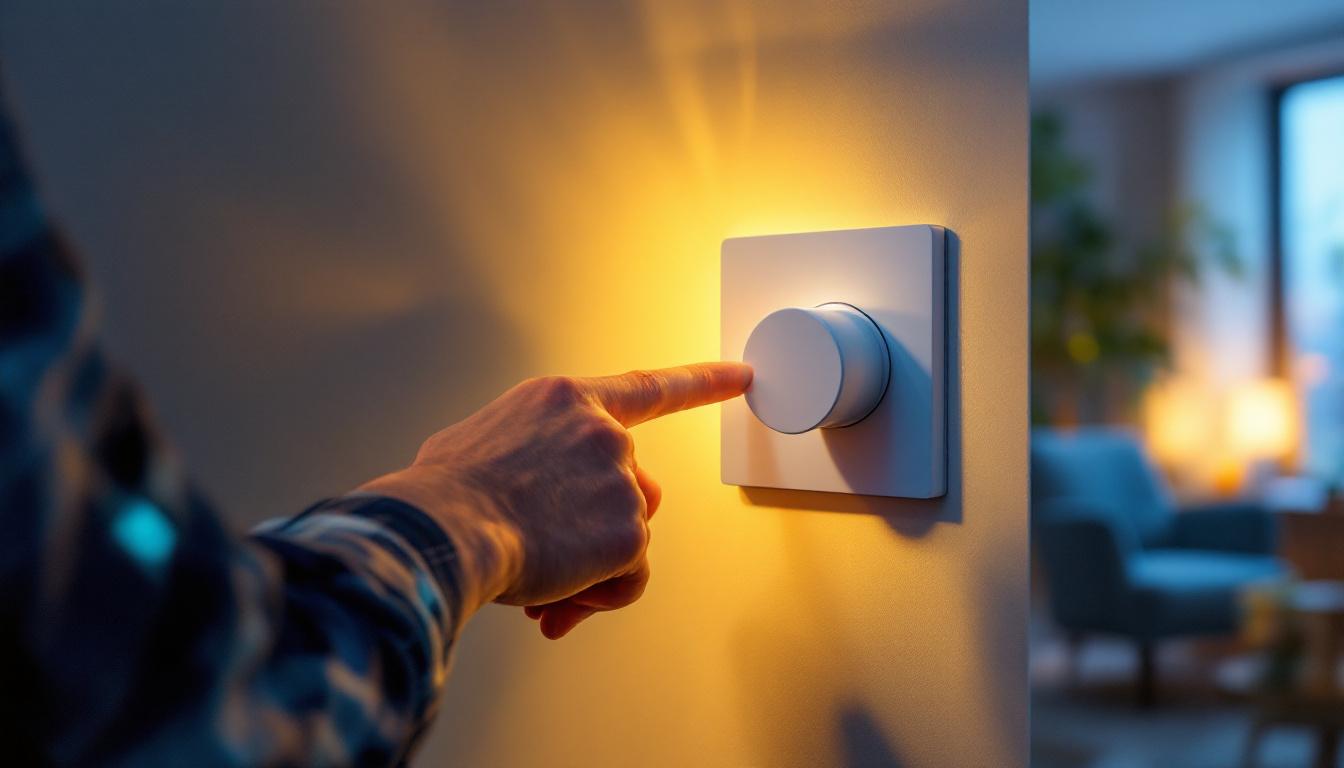
Dimmer switches are more than just a convenience feature; they are a fundamental component in controlling lighting ambiance and energy consumption. At its core, a dimmer adjusts the brightness of a light source by regulating the amount of electrical power delivered to the lamp.
For lighting contractors, grasping the technical operation of dimmers is essential. It’s not just about installing a device on the wall—it’s about integrating a system that affects the overall lighting design, energy efficiency, and client satisfaction. The right dimmer can transform a space, allowing for versatility in mood and functionality, from bright task lighting in a kitchen to a soft, romantic glow in a dining area.
Moreover, the integration of dimmers can lead to significant energy savings. By reducing the brightness of lights when full intensity is not necessary, dimmers can decrease energy consumption, extending the life of bulbs and reducing electricity bills. This not only benefits the environment but also aligns with the growing trend toward sustainable living and energy-efficient home solutions.
Traditional dimmers use a method called “phase control” to reduce voltage. They rapidly switch the power on and off during each AC cycle, effectively cutting the amount of electricity reaching the bulb. This happens so fast that the human eye perceives a dimmed light rather than flickering.
There are two main types of phase control: leading-edge and trailing-edge dimmers. Leading-edge dimmers, often found in older or incandescent setups, cut the front part of the AC waveform. Trailing-edge dimmers, which are more compatible with modern LED and low-voltage lighting, cut the latter part of the waveform, providing smoother dimming and less noise. This compatibility is crucial as the lighting industry shifts towards more energy-efficient solutions, ensuring that homeowners can enjoy the benefits of dimming technology without compromising on performance.
Additionally, advancements in smart home technology have led to the development of smart dimmers, which can be controlled via smartphone apps or voice commands. These innovative devices not only allow for precise control over lighting levels but also enable users to create schedules, set scenes, and even integrate with other smart home systems for a seamless experience. This evolution in dimmer technology reflects a broader trend towards automation and connectivity in home design, making it easier than ever for homeowners to customize their living spaces to fit their lifestyles.
Choosing the right dimmer isn’t just a technical decision; it influences project timelines, client outcomes, and long-term system performance. Lighting contractors must consider compatibility, installation complexity, and the specific needs of each project. The selection process can often dictate the overall aesthetic and functionality of the lighting design, making it a pivotal part of the planning phase.
One of the biggest hurdles contractors face is ensuring dimmer compatibility with various light sources. LEDs, for example, require specialized dimmers because they operate at lower wattages and have different electrical characteristics than incandescent bulbs. As the market continues to shift towards energy-efficient lighting solutions, understanding these nuances becomes increasingly critical for contractors aiming to deliver high-quality installations.
Using an incompatible dimmer can cause flickering, buzzing, or even damage to the lighting fixtures. This not only leads to customer dissatisfaction but also increases call-backs and warranty claims—issues that can tarnish a contractor’s reputation. Additionally, the financial implications of these mistakes can be significant, as contractors may find themselves absorbing costs for replacements or repairs that could have been avoided with proper planning and product selection.
Installing dimmers involves more than wiring a switch. Contractors need to understand the electrical load, the type of wiring available, and the control options desired by the client. For instance, multi-location dimming systems, which allow control from several switches, require additional wiring or wireless communication protocols. These systems can enhance user experience by providing flexibility and convenience, but they also add layers of complexity to the installation process.
Moreover, dimmers generate heat during operation, so proper installation must account for adequate ventilation and load limits to prevent premature failure or fire hazards. Contractors should also be aware of the latest advancements in dimmer technology, such as smart dimmers that integrate with home automation systems. These modern solutions not only improve energy efficiency but also offer enhanced control options, allowing users to adjust lighting settings via smartphones or voice commands. As technology evolves, staying informed about these innovations can set contractors apart in a competitive market, ultimately leading to more satisfied clients and successful projects.
Dimmer switches contribute significantly to energy savings by reducing power consumption when lights are dimmed. For contractors, this is a key selling point when discussing project benefits with clients. The ability to control lighting levels not only enhances the ambiance of a space but also empowers clients to tailor their energy usage according to their needs, making dimmers an attractive addition to any project.
When lights are dimmed to 50%, they don’t just use half the energy—they often consume less due to the way dimmers regulate power. This translates into lower electricity bills and a smaller carbon footprint. Moreover, as energy prices continue to rise, the financial benefits of installing dimmer switches become even more pronounced. Clients can appreciate immediate savings on their utility bills while also contributing to a more sustainable environment, aligning with broader societal goals of reducing energy consumption and promoting eco-friendly practices.
Clients increasingly demand energy-efficient solutions, especially in commercial and hospitality projects where lighting accounts for a substantial portion of operating costs. Offering dimmers as part of a lighting design can set contractors apart in competitive bids. Furthermore, the versatility of dimmers allows for dynamic lighting scenarios that can enhance customer experiences in restaurants, hotels, and retail spaces. This adaptability not only meets client expectations but also opens up opportunities for upselling additional smart lighting technologies that can further optimize energy use and improve operational efficiency.
Dimming also extends the lifespan of bulbs by reducing the electrical stress on the filament or LED components. This means fewer replacements and less maintenance over time, which is a tangible benefit for property managers and homeowners alike. In commercial environments, where lighting fixtures are often used for extended periods, the longevity of bulbs can lead to significant savings in both replacement costs and labor associated with maintenance. Clients will appreciate the reduced downtime and disruption that comes with less frequent bulb changes, allowing for smoother operations in their facilities.
Additionally, the use of dimmers can enhance the overall lighting quality within a space. By allowing for finer control over brightness, dimmers can help in creating the perfect atmosphere for various activities, from hosting events to providing a relaxing environment in residential settings. This level of customization not only improves user satisfaction but also reinforces the value of investing in energy-efficient solutions. As clients become more aware of the benefits of smart lighting systems, incorporating dimmers into projects can position contractors as forward-thinking professionals who prioritize both functionality and sustainability.
Beyond technical and economic factors, dimmers enhance the overall lighting experience. Contractors who understand this can better tailor solutions to client needs, improving satisfaction and referral opportunities.
Lighting sets the mood in any space. Dimmers allow users to adjust brightness levels to suit different activities-from bright, focused light for work to soft, relaxing illumination for evenings.
For contractors, recommending dimmers means helping clients achieve versatile environments without installing multiple fixtures or complex lighting systems.
The rise of smart home and building automation has introduced new dimmer options that integrate with voice control, mobile apps, and occupancy sensors. Lighting contractors who stay current with these technologies can offer advanced solutions that appeal to tech-savvy clients.
Smart dimmers also provide data on energy usage and lighting patterns, enabling ongoing optimization and maintenance planning.
Despite their benefits, dimmers can cause headaches if not properly specified and installed. Awareness of common issues helps contractors prevent costly mistakes.
Each dimmer has a maximum wattage rating. Exceeding this limit can cause overheating and failure. Contractors must calculate the total wattage of connected lights and select dimmers accordingly, sometimes splitting loads across multiple dimmers.
Combining different bulb types on the same dimmer often leads to erratic behavior. For example, mixing halogen and LED bulbs can cause flickering or uneven dimming. Consistency in bulb selection is key.
Manufacturers provide detailed specifications for dimmer compatibility and installation. Overlooking these can void warranties and lead to system malfunctions. Contractors should always consult datasheets and technical support when in doubt.
Dimmer switches are a deceptively simple yet powerful tool in a lighting contractor’s arsenal. Understanding how they work and their impact on lighting projects enables contractors to deliver superior results-combining energy efficiency, design flexibility, and client satisfaction.
By carefully selecting compatible dimmers, adhering to installation best practices, and embracing smart technologies, lighting professionals can avoid common pitfalls and create lighting solutions that stand the test of time.
In the competitive field of lighting installation, mastering dimmer technology is not just an advantage-it’s a necessity for success.
Ready to harness the power of dimmers and elevate your lighting projects to new heights? At LumenWholesale, we provide lighting contractors with the highest quality, spec-grade dimmers and lighting solutions at unbeatable wholesale prices. Say goodbye to middleman markups and hello to a vast selection of reliable, high-performance products that meet the strictest industry standards. With the added convenience of free shipping on bulk orders, you can ensure your projects shine brightly while keeping costs down. Don’t compromise on quality or value—visit LumenWholesale today for Wholesale Lighting at the Best Value and make every lighting project a glowing success.

Discover the secrets to optimizing exterior door lighting for maximum efficiency.

Discover how F25T8 fluorescent lamps can revolutionize your lighting projects by saving contractors both time and money.

Discover the transformative impact of LED outdoor lighting for contractors.

Discover how to enhance your lighting projects with motion sensor lights while avoiding common pitfalls.